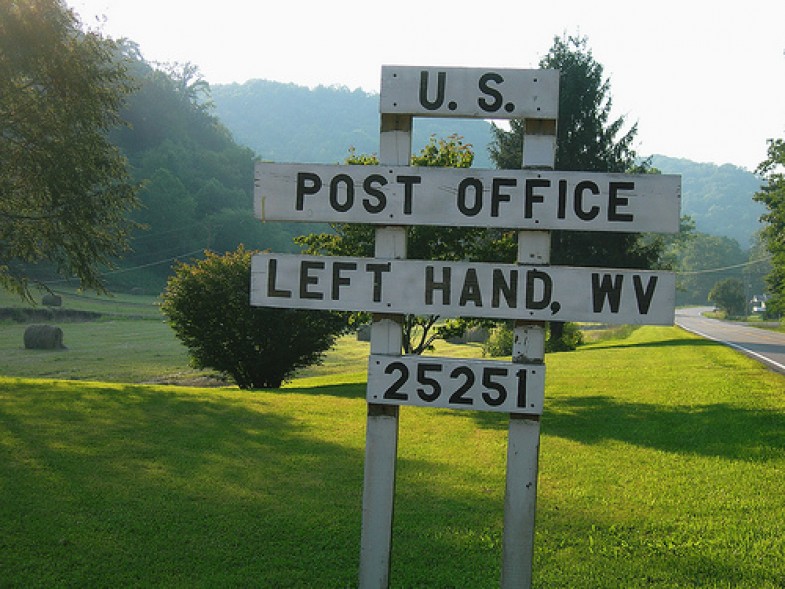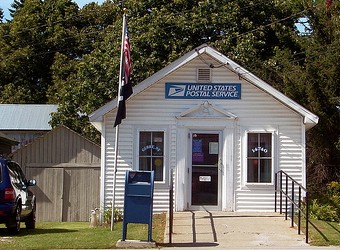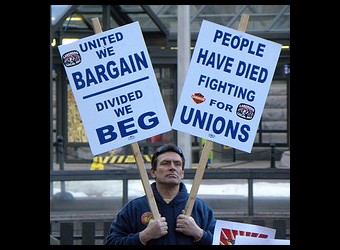Let’s begin with the bad news. The U.S. Post Office, the oldest, most respected and ubiquitous of all public institutions is fast disappearing. In recent years management has shuttered half the nation's mail processing plants and put 10 percent of all local post offices up for sale. A third of all post offices, most of them in rural areas, have had their hours slashed. Hundreds of full time, highly experienced postmasters knowledgeable about the people and the communities they serve have been dumped unceremoniously, often replaced by part timers. Ever larger portions of traditional post office operations--- trucking, mail processing and mail handling-- have been privatized. Close to 200,000 middle class jobs have disappeared.
Since 2012 the U.S. Postal Service (USPS) has lowered service standards three times, most recently in January when in preparation for closing an additional 82 mail processing plants it announced the end of one day delivery of local first class mail and an additional 1-2 days for all mail. Subscribers to Netflix’s DVD delivery service may soon discover the cost effectiveness of a monthly subscription has been cut in half because the number of DVD’s they can receive in a month has been cut in half.
We are told the Postal Servicehas fallen so deeply into debt (see sidebar) that it has exhausted its borrowing capacity. There’s no cash left. It’s been challenging to invest in capital projects. Post offices are in disrepair. Trucks are out of date.
Now for the good news. A year and a half ago, a slate of insurgents won seven of nine national offices at the American Postal Workers Union (APWU). What? Can the election of new officers in a single union, even one with over 200,000 members possibly save the post office? Certainly not if they try to do it singlehandedly but there’s a chance, just a chance they could turn the tide if they build an effective national movement. And that’s what they’re trying to do.
The New Postal Workers' Union Strategy
The APWU’s new officers are unusually experienced and talented organizers. After leading the Greater Greensboro Area Local for 12 years and co-founding the Greensboro Chapter of Jobs with Justice, President Mark Dimondstein was appointed APWU’s National Lead Field Organizer in 2000 in a new campaign to organize workers in privatized mail trucking and processing operations. That afforded him important experience in the rough and tumble world of the private sector where workers have the legal right to strike (post office workers can’t) and corporations have the legal right to do almost anything they want to thwart union organizers. The campaign had many successes but prolonged strikes against several companies eventually exhausted the union’s strike fund and its national leadership refused repeated requests by Dimondstein and others to replenish it,
Other new officers include Political Director John Marcotte who organized a local coalition that stopped the consolidation of a plant in Michigan and Executive Vice President Debby Szeredy who led her Mid-Hudson local in upstate New York to fight their plant closure. Both she and the new Clerk Craft Director Clint Burelson also participated in a hunger strike in 2012.
The activist stance of these new leaders is evident in the tactics they embrace. Dimondstein insists, "We're not afraid of the streets. We're not in the streets enough. We need to picket, march, sit-in--not leave it to lobbying or one-on-one negotiations." He pointedly praises the actions of postal workers who 55 years ago this March took their future into their own hands by defying union leaders and staging an illegal strike against low pay and benefits and poor working conditions.
The 1970 strike galvanized postal workers and stunned the nation. “So invisible were the docile, dependable men in gray until last week that no one noticed that their passions were about to explode into a historic and ominous strike,” TIME magazine reported a week later, “The first national postal stoppage in U.S. history and the largest walkout ever against the Federal Government…the illegal strike, which started in New York City, quickly spread to surrounding areas and gradually began marching north to New England and westward across the country, hitting Akron, Buffalo, Chicago, Cleveland, Dearborn, St. Paul, Detroit, Denver and San Francisco By week's end the strike had either shut down or curtailed service in more than 30 major cities, and was still spreading.”
The strike resulted in the transformation of Walmart-like jobs into middle class jobs with good benefits and working conditions. For the first time postal workers gained the right to bargain collectively. And the APWU was born from the merger of five postal unions.
The new leadership has undertaken four overlapping and mutually reinforcing organizing strategies intended to protect their members and resurrect the public mission of the post office.
1. Postal Worker Activism
One strategy is internal: instilling a renewed sense of individual activism in the APWU. Dimondstein envisions a "cultural shift from a service model to an organizing model of unionism."
People are disengaged not because they don't care but because they see their union dues as a premium to an insurance company or as lawyer's fees,” he maintains. “We need to retool, to retrain people to see the union as themselves. We need to encourage workers to take their grievances directly to the boss, in groups, not just file paperwork and wait for union officials to service them. We need more of a movement, a sense of connection to the larger community, which will give postal workers hope and confidence.”
2. Partnerships With Other Postal Unions
The other three strategies are external. One involves an active working partnership with the other three postal unions. (National Postal Mail Handlers, National Association of Rural Letter Carriers, National Association of Letter Carriers). “The idea that we have different fights, it’s the classic divide and conquer,” says Dimondstein. Six months after the APWU election, the Postal Union Alliance was born to coordinate a fight that cuts across union jurisdictions: stopping processing plant consolidations, the closure and downgrading of local post offices, and the end of direct-to-the-door delivery and Saturday mail delivery.
3. Partnership With Other Unions
The second external strategy is to expand the partnership to non-postal unions. Last year when USPS management launched a project designed to create mini post offices in big box retail stores, a step toward eliminating local post offices, this new partnership became evident. USPS chose Staples as the site of its pilot project.
In April A Day of Action generated hundreds of pickets, marches and rallies in more than 50 cities across 27 states under the rallying cry, “Stop Staples: The U.S. Mail is Not for Sale.”
In May Staples Vice Chairman Joe Doody nervously acknowledged that its deal with the USPS “could become a problem if more unions backed the postal workers.”
In June California’s Service Employees International Union 32BJ, representing 145,000 union members in 11 states and the District of Columbia, endorsed a boycott of Staples. In July the International Association of Firefighters representing more than 300,000 followed suit. AFSCME, representing 1.6 million public-sector workers, signed on as well.
Addressing the national convention of the 1.5 million member American Federation of Teachers (AFT) Dimondstein made the case for solidarity, “We too are in the public sector, we too are meeting the needs of people. We’re facing some of the same problems you are—I call it divert, defund, demoralize, demonize and dismantle.” On July 12th the AFT endorsed the boycott. School supplies are a key market for Staples, accounting for up to one-third of its sales.
On July 14th Staples announced it was withdrawing from the pilot project.
4. A Grand Alliance
The third external strategy is to broaden the partnership to private as well as public unions and to build “a grand alliance between the people of this country and postal workers.” On February 19h, that Grand Alliance launched the same day the APWU began negotiating a new contract, the first not only for Dimondstein but also for the new Postmaster General Megan Brennan. In a highly unusual expression of solidarity APWU was joined that day by the Presidents of the AFL-CIO, National Association of Letter Carriers, Communication Workers of America, American Federation of Government Employees, AFSCME, and the Coalition of Black Trade Unionists. Some 64 civil rights, labor, community and religious organizations had signed on with the Alliance.
The contract negotiations will tackle bread and butter labor issues including ending a three-tiered structure that gives workers significantly different amounts pay for the same job and offers new hires barely a living wage. But Dimondstein promises they will also “promote a vision of a vibrant Postal Service for generations to come.” That includes fighting to regain high delivery standards, halt plant closings, expand hours of service and staffing for customers and use the USPS universal infrastructure to deliver new services such as public banking to generate new revenue.
What is to be done?
With Republicans in control we cannot expect Congress to lift a finger to save the post office. But USPS’s management can do a great deal to revive this hallowed American institution even without Congressional approval if only it can be persuaded to take the public interest into account.
So far the USPS Board of Governors and its previous Postmaster General have been unwilling to do so. Indeed, sometimes they seemed to go out of their way to justify an assault on their own institution. When the Postal Service was planning to close processing centers it contracted with a market research firm to survey mailers about how they would react. Its study found that mailers would curtail their volumes so much that the losses to the Postal Service could erase any savings from the plant closures. Rather than shelve its plan USPS management buried the study and had another done based on a differebt format and questions that arrived at a more palatable (to management) conclusion.
USPS management’s approach to closing local post offices would be welcome in the Boardrooms of Sears or Walmart but is inappropriate in a public institution. Consider that according to the USPS itself the closing of several thousand post offices would save the post office a paltry $200 million out of a budget of $55 billion but the real cost to thousands of communities and millions of Americans will be far, far greater.
The Wall Street Journal carried an instructive story about the unquantifiable costs that result from shutting down a post office. Closing the Prairie City, South Dakota post office saved the USPS $19,000 a year. But as Daniel Beckman, a recently widowed farmer, observed, postal clerks kept a pot of coffee brewing and posted birth and death notices. “That was the gathering place for people to come in the mornings, have a cup of coffee or a can of pop, and visit, but we don’t have that no more.”
The area’s only major hospital and pharmacy is in Hettinger, N.D., 40 miles away and over the state line. When someone in Prairie City quickly needed medication, a pharmacist in Hettinger would rush prescriptions to the Hettinger post office, catching the mail carrier who each day delivered to the Prairie City post office. Closing the Prairie City post office eliminated that direct route, delaying the delivery of medicine by two or three days.
Even if USPS management simply took into account the quantifiable costs to a community resulting from the loss of a post office (an analysis that by my reading it is legally required to undertake), it would close very, very few of them. The only genuine cost-benefit analysis of which I am aware was done not by the USPS but by students in an economic class at the University of Wisconsin. They identified a tiny post office the USPS would clearly mark for closure and concluded that would save the USPS about half a million dollars but cost the community, just in increased travel time and expenses, more than $700,000.
The APWU hopes to shine a spotlight on these true costs to the public in order to recruit communities across the country into a national coalition to demand that the public interest must be taken into account.
The APWU also promises to ask USPS management to introduce new services that can benefit both its customers and its balance sheet. Public banking is one service the APWU has identified. The concept has received widespread attention since a study by the postal service inspector general concluded that if the USPS captured 10 percent of the interest and fees generated by the 68 million Americans on the fringes of the banking system it could generate $8.9 billion in annual revenue to the USPS. Dimondstein believes Congress need not approve the introduction of banking services and has suggested a pilot program noting, “a third of the Zip codes in America don’t have a bank.”
Union-management contract negotiations usually take place far from the public eye and involve only those at the bargaining table. But in some respects this spring the APWU is negotiating on behalf of all of us. Its intention is not only to force postal management to treat its workers with respect but to respect the unique public nature of this most public of all institutions. We all would do well to join the APWU in its Grand Alliance.






